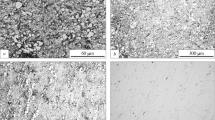Abstract
Some requirements are formulated for tool steels used to make tools with their durability being limited by strength and impact resistance rather than by wear resistance. It is shown that the high-speed steel belonging to a new hypereutectoid class is optimal for the above-mentioned application. The fracture mechanisms are considered for ledeburitic (R6M5) and hypereutectoid (11M5F) classes of tool steels. It is demonstrated that critical length crack formation in hypereutectoid steels takes place not only by means of elastic but also by means of considerable plastic deformation; on this account, the work of crack initiation in 11M5F considerably exceeds that of R6M5. The above-mentioned fact is due to the peculiarities of 11M5F steel microstructure characterized by extremely fine grain and the absence of eutectic carbides. Correlation between fracture work and deformation is established under static bending (on one hand) and impact strength (on the other hand) conditions.
Similar content being viewed by others
References
Geller, Yu.A., Instrumental’nye stali (Tool Steels), Moscow: Mir, 1978; Moscow: Metallurgiya, 1983.
Adaskin, A.M., Applicability of R6M5 steel, Russ. Eng. Res., 2010, vol. 30, pp. 186–189.
Kremnev, L.S., Critical coefficient of stress intensity and fracture toughness of high-strength tool materials, Metal Sci. Heat Treat., 1996, vol. 38, pp. 33–37.
Kremnev, L.S., Alloying theory and its use for creation of heat-resistant tool steels and alloys, Metal Sci. Heat Treat., 2008, vol. 50, pp. 526–534.
Adaskin, A.M., Kremnev, L.S., and Sapronov, I.Y., Fracture of ledeburite and hypereutectoid high-speed steels, Metal Sci. Heat Treat., 2011, vol. 53, pp. 280–284.
Vereshchaka, A.S., Grigor’ev, S.N., and Tabakov, V.P., Methodological principles of production of functional coatings of the new generation for application in tool production, Spravochnik. Inzhenernyi Zh. s Prilozheniem, 2011, no. 12, pp. 13–22.
Volosova, M.A. and Tumanov, A.A., Sistematization of methods of coating superimposing and modification of work surfaces of cutting tool and algorithm of their choice, Vestnik Mos. Gos. Tekhn. Univ. Stankin, 2011, no. 3, pp. 78–83.
Sobol, O.V., Andreev, A.A., Grigoriev, S.N., Volosova, M.A., and Gorban, V.F., Vacuum-arc multilayer nanostructured TiN/Ti coatings: Structure, stress state, properties, Metal Sci. Heat Treat., 2012, vol. 54, pp. 28–33.
Cherkasova, N.Yu., Shein, A.A., Antonenkova, G.V., and Sotova, E.S., Study of mechanism and kinetics of wear of shearing dies from semi-heat-resistant steels in machining articles made from various structural materials, J. Fric. Wear, 2013, vol. 34, pp. 214–220.
Adaskin, A.M., Use of the effect of stress relaxation for changing the shape of articles from nonplastic steels and alloys, Metal Sci. Heat Treat., 2012, vol. 54, pp. 47–51.
Smol’nikov, E.A., Termicheskaya i khimiko-termicheskaya obrabotka instrumenta v solyanykh vannakh (Thermal and Chemical-Thermal Treatment of Tool in Salt Baths), Moscow: Mashinostroenie, 1989.
Adaskin, A.M., Kremnev, L.S., and Sapronov, I.Yu., Effect of tempering temperature on hogging of R6M5 and 11M5F steels, Tekhnol. Met., 2006, no. 7, pp. 26–29.
Grigor’ev, S.N., Borisov, A.A., and Maslov, A.R., Instrumental ensuring of microtreatment, Spravochnik. Inzhenernyi Zh. s Prilozheniem, 2011, no. 12, pp. 32–37.
Johnson, K., Contact Mechanics, Cambridge: Cambridge Univ., 1985; Moscow: Mir, 1989, Goldshtein, R.V., Ed.
Yokobori, T., An Interdisciplinary Approach to Fracture and Strength of Solids, Groningen: Wolters-Noordhoff, 1968; Moscow: Metallurgiya, 1971.
Kremnev, L.S., Low-alloyed tungsten-free high-speed steels 11M5F and 11M5FYu and their heat treatment, Metal Sci. Heat Treat., 1987, vol. 29, pp. 870–872.
McLean, D., Mechanical Properties of Metals, Krieger, 1977; Moscow: Metallurgiya, 1965.
Freedman, Ya.B., Information on mechanical properties of metals, in Metallovedenie i termicheskaya obrabotka stali (Metal Science and Heat Treatment of Metals), Bernshtein, M.L. and Rakhshtadt, A.G., Eds., Moscow: Metallurgiya, 1983.
Adaskin, A.M., Kremnev, L.S., and Sapronov, I.Yu., Selection of steel and heat treatment conditions for cold upsetting of punches forming hexagon recess in screws blanks, Vestnik Mashinostr., 2005, no. 9, pp. 25–29.
Cherkasova, N.Yu., Shein, A.A., Antonenkova, G.V., and Sotova, E.S., Study of mechanism and kinetics of wear of shearing dies from semi-heat-resistant steels in machining articles made from various structural materials, J. Friction Wear, 2013, vol. 34, no. 3, pp. 214–220.
Author information
Authors and Affiliations
Corresponding author
Additional information
Original Russian Text © A.M. Adaskin, L.S. Kremnev, I.Yu. Sapronov, 2014, published in Perspektivnye Materialy, 2014, No. 2, pp. 48–54.
Rights and permissions
About this article
Cite this article
Adaskin, A.M., Kremnev, L.S. & Sapronov, I.Y. Tool steels of new generation. Inorg. Mater. Appl. Res. 5, 509–515 (2014). https://doi.org/10.1134/S2075113314050025
Received:
Published:
Issue Date:
DOI: https://doi.org/10.1134/S2075113314050025




